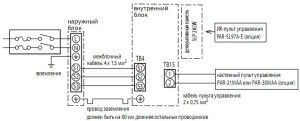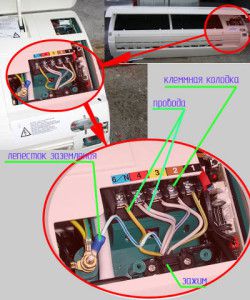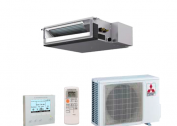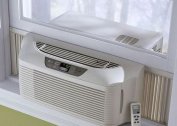After installation, the air conditioner should be connected to the mains, which is carried out according to the schemes indicated on both indoor and outdoor units. A detailed description of the stages of this process and the requirements for the mains are usually given in the instructions separately for each device, depending on its power.
General recommendations
It should be borne in mind that the electrical circuits for connecting the air conditioner for low-power household and more powerful semi-industrial (commercial) models differ. The former are single-phase, and the latter are both single-phase and three-phase.
There are two ways to power the split system: directly through the outlet and by bringing the wire to the electrical panel. The first option is suitable for household appliances and in the case of already completed repairs in the room. The second method is acceptable for powerful units, as well as for devices of various capacities at the initial stage of rough repair work. Household models are often put into operation in the first way, so this article will be considered in more detail in this article.
As a rule, powering a split system takes place in several stages, which should be strictly observed if the user plans to do this on his own. So, how to connect the air conditioner with your own hands without the corresponding experience? It is difficult, but quite feasible.
Work sequence
First of all, the owner of a split system is required to remember the sequence of work. They are carried out according to the following scheme:
- preparation of materials and tools;
- study of air conditioner connection schemes;
- laying interconnect cables - connecting them to the terminals of the indoor and outdoor units of the air conditioner;
- connecting the device to the network;
- checking the operation parameters of both modules.
Depending on the internal device, the cable can pass from both the outdoor and indoor units to the power source.
Connecting and connecting interconnect cables
If you decide to connect the air conditioner to the mains via an outlet, you need to make sure that it can withstand the upcoming load. In case of mismatch with the required parameters, the installer should not connect the device to it and must explain to the customer the essence of the problem, and also offer a way out - lay a separate line to the shield.
Here are the basic requirements for the outlet:
- The socket must have a ground or differential relay;
- It must correspond to the required values specified in the instructions for the split system. The best ratio is high network power and low power cooling device;
- Air conditioning is not placed in line with other powerful appliances;
- It is forbidden to power the device from the socket if aluminum wiring is used. To connect the air conditioner through it, you must take a copper wire with the appropriate cross-sectional area;
- It is important to make sure that the outlet itself is connected through an automatic machine that has a distance between the contacts of at least 3 mm in the open state;
- The work is carried out only by an experienced installer in accordance with the required state and local standards.
Subject to all the above requirements, they begin preparatory work on connecting the air conditioner to the outlet with their own hands. First, check for the presence of the necessary tools, and then strip the cable strands with a knife or a stripper.Now they proceed to laying interconnect cables and connecting the external air conditioning unit, and then the internal one.
Modern reinforced euro outlets are usually suitable for high power devices.
The connection is carried out according to the diagrams on the blocks, on which the terminal blocks corresponding to the interconnect cables are indicated. Unconnected cable cores must be insulated so that they do not come into contact with live parts of the air conditioner.
Terminal marking for on / off split systems:
- 1 - compressor power;
- 2 (N) - common neutral;
- 3 - four-way valve;
- 4 - fan of the external unit;
- (land).
Terminal marking for inverter split systems:
- 1 - nutrition;
- 2 (N) is neutral;
- 3 - management;
- (land).
In some Chinese economy air conditioners, a separate wire is laid between the units to connect the temperature sensor.
Wires are connected to the terminals. The terminal box is located under the block panel. In accordance with the numbering, the wires of the internal module are connected to the contacts of the external.
Stages
A brief instruction for connecting the air conditioner with your own hands for the indoor unit is as follows:
- Remove the decorative panel from the block.
- Remove the protective cover from the connectors and the cord retainer.
- Lay the interconnect cable through the mounting hole in the back of the device.
- Prepare the cable for connection, previously stripping it and stripping the insulation.
- The stripped ends are inserted into the terminals and tightened tightly with screws. Tightening forces should be approximately 1.2 Nm. Typically, terminal blocks use screw terminals for connecting wires.
- The interlock block wire is well fixed with clamps.
- Replace the terminal cover.
The same brief instruction is suitable in order to independently connect the air conditioner external unit. Instead of the decorative panel at the outdoor unit, remove the protective cover and connect it with wires to the internal module through the terminals.
At the very end, they check whether the work done corresponds to the connection diagrams. Only then can the device be turned on.
Selection of wires for connection
It is worth remembering which wire is needed to connect the air conditioner, or rather, which section is required. Its parameters are indicated in the instructions for each split-system model individually. The cross section depends on the power of the device. As a rule, household air conditioners (sizes 7, 9, 12, 13) require wire diameters from 1.5 to 2.5 mm². You can focus on the current strength: less than 18 A - 1.5 mm², more than 18 A - 2.5 mm².
Also, the wire required to connect the air conditioner to the mains is selected, given the remoteness of the shield. The distance between the unit and the electrical panel over 10 meters requires a cross section of 2.5 mm².
In order to ensure reliable operation of the air conditioner, only copper wires are used. For single-phase connection, three-wire wires (phase-zero-earth) are taken, and for a three-phase connection - five-wire.
The wire must not be laid near gas and heating pipes. The minimum distance between them is at least 1 meter. If necessary, use additional insulation. As a rule, the cable is laid along with the track in the corrugation and hidden in a box or a strob in the wall.
Clamps are attached to the cable wall, which are fixed with dowels or screws. When laying communications in boxes for their fastening, glue or screws are used. If hidden wiring is performed, then the wires are hidden in the corrugation and fixed to the wall with the help of special clamps.
Circuit breaker
If you plan to power the split system from the shield, then you need protection devices, one of which is a circuit breaker. It is selected relative to the rated power of the device indicated in the technical passport or on the external unit.It is advisable to always leave a small margin. For example, start-stop air conditioners have a very high starting current, surpassing 20 A. And although the duration of operation at these values is short, it is still worth considering.
It is possible to select the necessary values of the machine according to the formula: the air conditioner power (kW) is divided by the mains voltage (220 V) and the data obtained is increased by 20-30%.
When connecting the air conditioner to the mains, it is important to remember that the circuit breaker must have a distance between the contacts in the open state of at least 3 mm for each phase wire. Strictly observe the phasing: the order of connecting the phases must correspond to the order on the terminal block.
A type C circuit breaker is suitable for air conditioners. It fully ensures the safety of motor loads and has high response characteristics in case of emergency.
You must make sure that the switchboard allows you to install additional equipment in it.
It is worth remembering that both for the air conditioner and for other household electrical appliances, the most reliable is the connection via a separate line. With this option, it is not necessary to install a residual current device and a differential relay.
Connecting an LG ART COOL GALLERY air conditioner using electrical circuits
Below in the photo will be given the electrical circuit for connecting the LG air conditioner ART COOL GALLERY inverter type. The first circuit is the connection of the indoor unit, the second is the connection of the outdoor unit. The third photo is the terminal block of the external unit. The fourth photo is an indoor unit that is fully operational. The 9-system split system shown in the photographs is installed in the apartment, connected to a power outlet and works great. The installers used a copper power cable with a cross section of 1.5 mm².
In order to cope with all the steps yourself, you can watch the video of installing and connecting the air conditioner with your own hands below:










